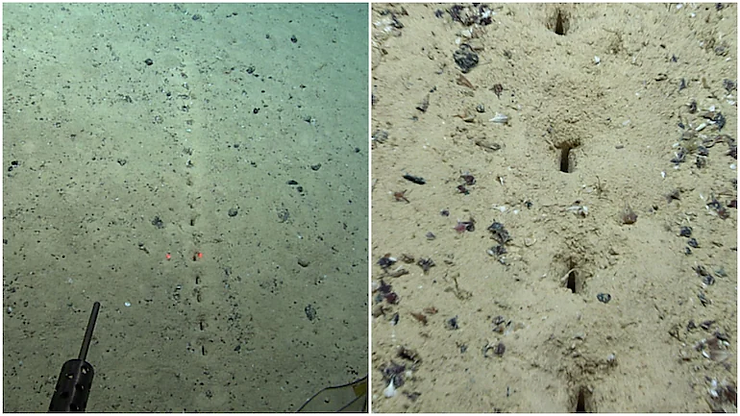By: Sophia Wang
In the waters along a volcanic ridge in the bottom of the Atlantic Ocean, sea explorers are using remotely operated vehicles to examine largely unexplored areas with a pattern of holes in the sand.
Earlier in the year, the National Oceanic and Atmospheric Administration (NOAA) started a five-month collaboration with some partners in hopes of mapping the Charlie-Gibbs Fracture Zone, the Mid-Atlantic Ridge, and the Azores Plateau. During the fourth dive of the expedition, researchers came upon a series of holes in the seafloor.
This wasn’t the first time holes like this were discovered. In July 2004, scientists discovered several sets of these holes while exploring at a depth of 2,082 meters (6,831 feet) along the northern Mid-Atlantic Ridge. These holes have a depth of approximately 1.6 miles below the ocean’s surface. They have a rectangular shape, and appear in a straight line in regular intervals a few inches apart. During the dive, scientists attempted to probe the holes with instruments and look inside but were not successful.
The shape and regularity of the holes give the impression that they have been made by humans. However, by all accounts, they aren’t the result of the expedition itself. It is unclear what other human technology could be responsible. Dr. Vecchione said that the holes seen on Thursday appeared to have been pushed out from underneath. In a research paper about the holes in 2004, Dr. Vecchione and his co-author, Odd Aksel Bergstad, proposed two main hypotheses for why the holes exist. Both hypotheses involved marine life either walking or swimming above the sediment and poking holes down, or the opposite, which would be marine life burrowing within the sediment and jabbing holes up.
NOAA scientists have gone to Twitter and Facebook to get theories on what these holes could be. The Unknown Explorer (@TUExplorer1) wrote on July 25, 2022, “Little critters could have used them after they were made by a something manmade?” William Boulet (@wgboulet) wrote a simple answer on July 26, 2022. “Ants.” There are many theories across Twitter and Facebook.
The goal of underwater volcano exploration is to find out what lives near underwater volcanoes as well as what happens if geologic processes that produce life-sustaining heat are interrupted. Close attention is being given to the deep-sea coral and sponge communities, which are “some of the most valuable marine ecosystems on Earth,” says Derek Sowers, an expedition coordinator aboard the NOAA ship, the Okeanos Explorer.
The scientists want to gather more information about the areas where seawater is heated by magma, because deep sea life doesn’t gain energy from the sun, instead gaining it from the heat of magma and chemicals, which is unique, because almost all life on Earth gets energy from the sun.
“It reinforces the idea that there is a mystery that some day we will figure out,” said Dr. Vecchione, upon seeing that the scientists still did not have an explanation for the deep sea holes. “But we haven’t figured it out yet.”
Links: https://s3.amazonaws.com/appforest_uf/f1659262048137x643432466058633000/There%20Are%20Holes%20on%20the%20Ocean%20Floor.%20Scientists%20Don%E2%80%99t%20Know%20Why.%20-%20The%20New%20York%20Times.pdf, https://www.syfy.com/syfy-wire/scientists-discover-mysterious-holes-in-the-ocean-floor, https://oceanexplorer.noaa.gov/news/oer-updates/2022/mysterious-holes-seafloor/mysterious-holes-seafloor.html, https://www.greenmatters.com/news/ocean-floor-holes (for twitter theories)











